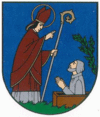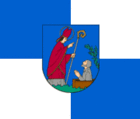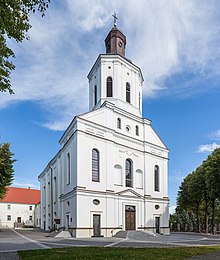Telšiai
| Telšiai | |||
|
|||
| State : |
|
||
| District : | Telšiai | ||
| Rajong municipality : | Telšiai | ||
| Coordinates : | 55 ° 59 ′ N , 22 ° 15 ′ E | ||
| Area (place) : | 17 km² | ||
| Community area : | 39.1 km² | ||
| Inhabitants (place) : | 29,764 (2010) | ||
| Population density : | 1,751 inhabitants per km² | ||
| Inhabitant (municipality) : | 55,230 (2007) | ||
| Population density : | 1,413 inhabitants per km² | ||
| Time zone : | EET (UTC + 2) | ||
| Postal code : | LT-87001 | ||
| License plate : | + 370- | ||
| Status: | Rajong Parish | ||
| Structure : | 1 city office (core city), 9 further administrative districts |
||
| Mayor : | Valdemaras Ramšas ( Tvarka ir teisingumas ) |
||
| Website : | |||
|
|
|||
Telšiai (in local Samogi : Telšē ; Yiddish טעלז Telz ; German: Telsche (n) or Telschi ) is a town and seat of the Rajongemeinde of the same name in western Lithuania , in the region of Lower Lithuania (Lithuanian: Žemaitija, ancient: Samogitia), of which it is the original provincial capital. Telšiai is the seat of the Telšiai administrative district . The city has developed into an important religious center for Jews and Christians since the 17th century. Telšiai is the Roman Catholic bishopric and houses a Catholic seminary and a Bernardine monastery.
city
The core town of Telšiai is located about 29 km east of Plungė . The urban area extends around Lake Mastis and along the Durbinis River and includes seven hills.
The city's original star-shaped floor plan has been preserved to this day. The cityscape is determined by the brick architecture of the early 20th century, but buildings from the 17th and 18th centuries have also been preserved. The center of Telšiai is dominated by the Bishop's Cathedral (Lithuanian Šv. Antonio Paduviečio katedra ), which is situated on a hill and consecrated to St. Anthony of Padua . It was built in the second half of the 18th century in the late Baroque style. The richly decorated interior with seven altars, stylistically assigned to the transition period between Renaissance and Classicism , is worth seeing .
The seminary next to the cathedral looks back on more than two hundred years of history and is one of the most important institutions of its kind in Lithuania. It was founded in 1740, but was closed by the Russian and Soviet authorities between 1863 and 1927 and again between 1946 and 1989. Opposite it, the Bishop's Palace was built in 1929.
The main street of Telšiai, the Respublikos gatvė ("Street of the Republic") runs between the central town hill and the Mastis Lake and leads to the market square ( Turgaus aikštė in Lithuanian ) with the town hall and a bell tower with a dome in the middle of the square. The black bear under the hood can be found in the city arms.
In 2016 Telšiai was the cultural capital of Lithuania .
economy
Telšiai is considered the center of forestry. It is located on the important rail and road links between Klaipėda and Šiauliai .
Former Telšiai yeshiva
Until the Soviet occupation of Lithuania in 1940, the Telsche Yeshiva ( Hebrew ישיבת טלז Yeshivat Telz , Yiddish טעלזער ישיבֿה Telzer Yeshive). The yeshiva achieved fame for its educational concept, which encompassed traditional and modern secular content, and for the years 1910 to 1930 under the direction of Rabbi Joseph Leib Bloch (1860–1930), who advocated improved, comprehensive education for boys and girls many yeshivot has been formative to this day.
This approach became the yardstick of the Lithuanian government in 1924 for the recognition of yeschives as higher education institutions. The Telšē yeshiva was initially the only institution of its kind in Lithuania that achieved the status of a state-recognized rabbinical seminary. The traditional Jewish teaching was not neglected.
As early as 1922, the yeshiva opened a college ("postgraduate college") that prepared for the rabbi exam. The admission criteria were so strict that the Kollel soon gained the reputation of an exclusive higher education institution. The teaching content and units (shiurim) of the teaching rabbis were sold in print as teaching aids and were widely used in other yeshivot and are still highly regarded at rabbinical seminars to this day.
A less successful Jewish teachers 'seminar founded by Joseph Carlebach and Leo Deutschlander in Kaunas in 1918 moved Bloch to Telšē in 1925 and reorganized it as a Jawne teachers' seminar under the auspices of the rabbinical seminary . In 1927 Bloch opened a Jewish secondary school for girls who had not had access to high-quality and comprehensive educational opportunities that included Jewish content.
From 1930 the teachers' department of the Jawne seminar offered the graduates of the high school the opportunity to qualify for this profession as well. Both the graduates and the graduates of the seminar were in demand as teachers at Jewish schools in Germany and abroad.
The primary schools for girls and boys founded in 1920 also belonged to the complex of the rabbinical seminary, so that all levels of education were covered.
After Bloch's death, his son Rabbi Avraham Jizchaq Bloch ran the institution. His brother Rabbi Eliahu Meir Bloch and both brother-in-law Rabbi Chaim Mordechai Katz were in the USA to collect donations for the rabbinical seminary when Germany and shortly afterwards the Soviet Union attacked Poland . E. M. Bloch and Katz planned to move the entire facility to the United States. In Cleveland , Ohio, they founded the Rabbinical College of Telshe, which still exists today, in October 1942 as a continuation of the institution in Telšē (now the seat in Wickliffe (Ohio) ). It was not possible to get the students and relatives from Lithuania to a safe foreign country.
With the Soviet occupation of Lithuania in June 1940, the institution was closed and most of the students left Telšē. About a hundred remaining students and faculty continued to hold courses on a private basis. When the Wehrmacht marched in in June 1941 , Rabbi Chaim Stein managed to escape with a group of students to the Soviet Union, from where they came to the USA after the Second World War.
German occupiers and their local collaborators murdered most of the remaining Jews in Telšē (including A. Bloch) on July 15, 1941 and in the years up to 1944, as did most of the other Jews in Lithuania . The buildings of the rabbinical seminary and its other institutions still exist. Ezriel Carlebach (a nephew of Joseph Carlebach), once a student at the rabbinical seminary, put a written memorial to the city, the institution and the Jewish community of Telšē with his stories Das Städtchen (Telschi) and Telschi. I. The yeshiva .
Rajong Parish
places
The Rajong community ( Telšių rajono savivaldybė ) includes:
- behind the line population figures 2001/2010 -
- 2 cities
- Telšiai - 31460/29764
- Varniai - 1355
- 11 towns ( miesteliai ):
- Eigirdžiai - 746
- Gadūnavas
- Janapolė
- Lauko soda
- Luokė - 777
- Nerimdaičiai
- Nevarėnai - 659
- Pavandenė
- Tryškiai - 1555
- Ubiškė
- Žarėnai
- 415 villages including:
- Rainiai - 1070
- Degaičiai - 880
- Ryškėnai - 854
- Dūseikiai - 727
Administrative division
The community is divided into 11 offices ( seniūnijos ):
- Degaičiai
- Gadūnavas
- Luokė
- Nevarėnai
- Ryškėnai
- Telšiai city
- Tryškiai
- Upyna
- Varniai
- Viešvėnai
- Žarėnai
Town twinning
A partnership has existed with Bassum in Germany since 2009
sons and daughters of the town
- Elias von Cyon (1843–1912), physiologist and writer
- Gabriel Narutowicz (1865–1922), Polish hydraulic engineer and politician, first President of Poland
- Avraham Jizchaq Bloch (1891–1941), rabbi at the Telšē Rabbinical Seminary
- Justas Paleckis (1899–1980), politician, President of the Lithuanian Soviet Socialist Republic
- Vladas Žulkus (* 1945), archaeologist
- Adomas Butrimas (* 1955), Professor of Archeology
- Rolandas Paksas (* 1956), former President of Lithuania (removed from office)
- Vytautas Kleiva (1959–2015) music teacher, politician and mayor
- Eugenijus Gentvilas (* 1960), former Prime Minister of Lithuania, member of the European Parliament
- Gediminas Šugžda (* 1968), football player
- Darius Trijonis (* 1973), Roman Catholic clergyman, auxiliary bishop in Vilnius
- Jurga Šeduikytė (* 1980), singer and songwriter
- Irmantas Zelmikas (* 1980), football player
- Giedrius Arlauskis (* 1987), football player
- Simona Kiseleva (* 1987), chess player
literature
- The fate of the Jews of the city of Telsiai , in: Wassili Grossmann , Ilja Ehrenburg (Hrsg.): Das Schwarzbuch. The genocide of the Soviet Jews . Editor of the German edition Arno Lustiger , German by Ruth and Heinz Germany, Rowohlt, Reinbek bei Hamburg 1994, pp. 674–676
Web links
- Telsiai.info (Lithuanian)
Individual evidence
- ^ Günther Schäfer: Lithuania . Verlag Peter Rump, Bielefeld 2009, p. 382
- ^ Esriel Carlebach: The town (Telschi) . ( Memento of the original from July 17, 2011 in the Internet Archive ) Info: The archive link was automatically inserted and not yet checked. Please check the original and archive link according to the instructions and then remove this notice. In: Menorah , Vol. 5, Issue 2 (February 1927), pp. 105-108.
- ^ Esriel Carlebach: Telschi. I. The yeshiva . 4 parts. In: Menorah ; Vol. 4, Issue 1 (January 1926), pp. 37–44 (= Part 1) ( Memento of the original from July 17, 2011 in the Internet Archive ) Info: The archive link was inserted automatically and has not yet been checked. Please check the original and archive link according to the instructions and then remove this notice. , Issue 2 (February 1926), pp. 112–116 (= part 2) ( Memento of the original from July 17, 2011 in the Internet Archive ) Info: The archive link was inserted automatically and has not yet been checked. Please check the original and archive link according to the instructions and then remove this notice. , Heft 4 (April 1926), pp. 231–235 (= part 3) ( Memento of the original from July 17, 2011 in the Internet Archive ) Info: The archive link was automatically inserted and not yet checked. Please check the original and archive link according to the instructions and then remove this notice. and Issue 12 (December 1926), pp. 692–694 (= part 4) ( Memento of the original of July 17, 2011 in the Internet Archive ) Info: The archive link was automatically inserted and not yet checked. Please check the original and archive link according to the instructions and then remove this notice. .






